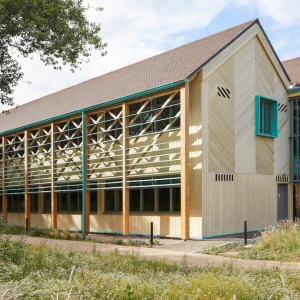
In 1975 an exhibition titled New Topographics was shown at the International Museum of Photography at George Eastman House, New York. Curated by William Jenkins it featured photographs from ongoing projects by Robert Adams, Bernd and Hilla Becher, Joe Deal, Frank Gohlke, Nicholas Nixon and Stephen Shore, among others.
Although it received little critical attention at the time, it has come to be seen as a crucial moment in defining documentary photography’s engagement with the contemporary urban condition. The New Topographics exhibition also served as an important litmus test of the influence of a wider thinking about the changing nature of the city, landscape and urbanisation. By the mid-1970s the central importance of man’s intervention and management of the landscape was being addressed across a number of professional, academic and popular discussions. In its broadest application, the concept of landscape had come to represent thinking about the very world in which we live.
This growing interest in the realities of land use was paralleled by investigations into city life and urban development by architects, urbanists and an emerging cultural landscape movement. In the US this interest focused both on the broad changes in human activity as much as detailed studies into the main streets, back alleys and carparks of America, which underpinned journals such as Landscape, as much as the research of Robert Venturi and Denise Scott Brown’s Las Vegas Studio.
Other influences were equally important in shaping the subsequent critical reactions to the New Topographics, including an increasing focus on the use of photography by conceptual artists such as Ed Ruscha, as well as the emerging practices of land art and a growing environmental consciousness. This process was of course not just a one-way street. Ruscha had already published a number of artist photo books such as Twentysix Gasoline Stations, 1963, and Thirty Four Parking Lots, 1965. His books had made an impression on both Baltz and Shore, and he himself was similarly influenced by the work of photographers such as Walker Evans and Robert Frank. His project photographing Every Building on the Sunset Strip, 1966, had also had a significant impact on Venturi and Scott Brown.
The New Topographics exhibition put a name to a moment in the development of the featured photographers and provided an important document to ideas that were ‘in the air’. This accounts in part for its continued importance. So too does the fact that it was organised at a time when there was a considerable cross-fertilisation of ideas between documentary realism, conceptual art and architectural research.

The photographs, original catalogue and essay by Jenkins have been continuously debated at a critical level, as well as informing the approach of a range of photographers working since the 1970s, including Gabriele Basilico, John Davies, Axel Hütte and Andreas Gursky, among others. The latter two were students of the Bechers and have become known as part of the Düsseldorf Tendency, after the academy where the Bechers’ taught.
Against this background, the New Topographics exhibition has been restaged by the Centre for Creative Photography at the University of Arizona and the George Eastman House International Museum. The new exhibition features more than 100 of the initial 168 photographs and will travel to Europe in November 2010, after touring the US, allowing the original works to be viewed together for the first time in 35 years. One reason for the continued influence of the 1975 exhibition rests with the printed catalogue. Although originally only a modest publication with 27 reproductions, it still allowed a greater number of people to access the work. For all of the New Topographics photographers, print publication has been central to their outlook.
Photographic publisher Steidl has produced a beautifully printed book to accompany the show. It greatly expands the number of reproductions and also includes a facsimile copy of the original catalogue, a checklist of all photographs from the show and essays by Britt Salvesen and Alison Nordström. The 1975 catalogue only had a small print run and has long had the status of a rare book. Steidl’s publication puts the images back into circulation and provides a possible point of departure for new discussions among urbanists, architects and photographers, on the relationship between documentary photography and urban thinking.
At its centre, the New Topographics was concerned with the man-made world. Thirty-five years on, the photographers’ work remains as relevant as when they first made their excursions into the landscapes of the American everyday.
David Cowlard is a freelance photographer. He recently submitted his Masters by Research thesis at Kingston University, titled Photourbanism: Documentary Photography and Urban Thinking.
www.urbanexposure.co.uk





